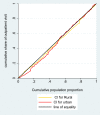Inequality and Inequity in Outpatient Care Utilization in Ethiopia: A Decomposition Analysis of Ethiopian National Health Accounts
- PMID: 33564248
- PMCID: PMC7866908
- DOI: 10.2147/CEOR.S286253
Inequality and Inequity in Outpatient Care Utilization in Ethiopia: A Decomposition Analysis of Ethiopian National Health Accounts
Abstract
Background: Inequity in healthcare use is avoidable inequality, and it exists when there are differences in the use of healthcare after standardization of different needs among the population. In Ethiopia, wide variation and lower achievement exists in outpatient visit per person per year against the target to reach by 2020. Therefore, this study is aimed at measuring inequalities and inequities in outpatient care utilization in Ethiopia.
Methods: The study utilized data from 2015/16 Ethiopian National Health Account survey. The analysis included a weighted sample of 42,460 individuals. Concentration curve and indices were used to measure inequality in outpatient care utilization. Deviations in the degree to which outpatient care was distributed according to need were measured by the horizontal inequity index. All statistical analyses were done using STATA version 14. In all analyses statistical significance was declared at a p-value < 0.05 and a 95% confidence interval.
Results: The outpatient care utilizations were found to be concentrated among the rich. The actual (C = 0.0335, 95% CI: 0.0298, 0.0431) and need predicted (C = 0.0157, 95% CI: 0.0117, 0.0413) utilizations were concentrated among the rich. The distributions of outpatient care in Ethiopians were pro-rich (rich-favoring). The decomposition analysis revealed that need factors were the main positive contributors to the inequality (23.6%) and non-need factors were among the negative contributors to the inequality (-48.4%).
Conclusion: This study evidenced the presence of rich-favoring inequality and inequity in outpatient care utilization in Ethiopia. Therefore, there is a need to consider implementation strategies that focus on fairness in healthcare utilization.
Keywords: Ethiopia; decomposition analysis; inequality; inequity; national health accounts; outpatient care utilization.
© 2021 Kifle et al.
Conflict of interest statement
The authors declared that they have no conflicts of interest for this work.
Figures



Similar articles
-
Growing old before growing rich: inequality in health service utilization among the mid-aged and elderly in Gansu and Zhejiang Provinces, China.BMC Health Serv Res. 2012 Sep 4;12:302. doi: 10.1186/1472-6963-12-302. BMC Health Serv Res. 2012. PMID: 22947369 Free PMC article.
-
Measuring socioeconomic inequalities in postnatal health checks for newborns in Ethiopia: a decomposition analysis.Front Public Health. 2024 Jun 5;12:1384729. doi: 10.3389/fpubh.2024.1384729. eCollection 2024. Front Public Health. 2024. PMID: 38903590 Free PMC article.
-
Equitable health services for the young? A decomposition of income-related inequalities in young adults' utilization of health care in Northern Sweden.Int J Equity Health. 2017 Jan 18;16(1):20. doi: 10.1186/s12939-017-0520-3. Int J Equity Health. 2017. PMID: 28100232 Free PMC article.
-
Income-related inequalities in health care utilization in Mongolia, 2007/2008-2012.Int J Equity Health. 2015 Jul 25;14:57. doi: 10.1186/s12939-015-0185-8. Int J Equity Health. 2015. PMID: 26204928 Free PMC article.
-
Horizontal inequity trends of health care utilization in rural China after the medicine and healthcare system reform: based on longitudinal data from 2010 to 2018.Int J Equity Health. 2023 May 17;22(1):90. doi: 10.1186/s12939-023-01908-4. Int J Equity Health. 2023. PMID: 37194035 Free PMC article.
Cited by
-
Rural-urban inequalities in health care utilization in Bhutan: a decomposition analysis.Int J Equity Health. 2024 Apr 12;23(1):69. doi: 10.1186/s12939-024-02178-4. Int J Equity Health. 2024. PMID: 38610030 Free PMC article.
-
Equity considerations for the implementation of health insurance benefit package in Ethiopia: result of expert Delphi exercise.Int J Equity Health. 2024 Sep 11;23(1):182. doi: 10.1186/s12939-024-02226-z. Int J Equity Health. 2024. PMID: 39261911 Free PMC article.
References
-
- FDRE MoH. Health Sector Transformation Plan. Addis Ababa, Ethiopia;2015:184
LinkOut - more resources
Full Text Sources
Other Literature Sources

